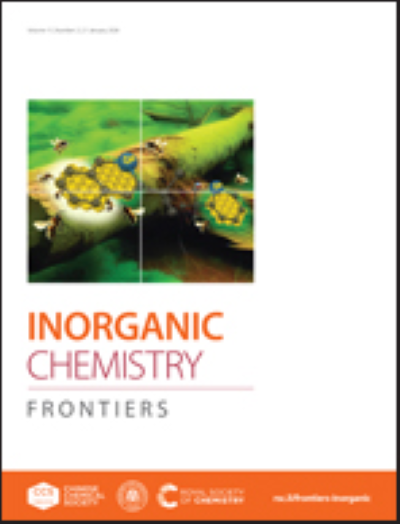Pt Single Atom and Atomic Cluster-Enhanced TiO2 Janus Micromotors for Efficient Bubble Propulsion and Photocatalytic Environmental Remediation
IF 6.1
1区 化学
Q1 CHEMISTRY, INORGANIC & NUCLEAR
引用次数: 0
Abstract
Bubble-propelled catalytic micro-/nanomotors, known for their strong thrust, rapid speeds, and long lifespan independent of ionic strength, have attracted significant attention. Despite significant advances in single-atom catalysis for its remarkable catalytic efficiency, single-atom catalysts alone generally lack sufficient activity to decompose hydrogen peroxide (H2O2) efficiently, limiting their applicability in bubble-propelled micro-/nanomotors for environmental use. Herein, we report a novel approach for fabricating Pt-decorated titanium dioxide micro-bowls (PtSA&C-TiO2) featuring dual active sites with atomically dispersed Pt single atoms (SAs) and atomic clusters (Cs). This design significantly enhances the propulsion capabilities of Janus micromotors, allowing the PtSA&C-TiO2 Janus micromotors to reach a speed of 113 ± 47 μm/s by decomposing H2O2 in aqueous solution, benefiting from the metallic characteristics of atomic clusters. Additionally, PtSA&C-TiO2 Janus micromotors exhibit superior photocatalytic performance in pollutant degradation, demonstrating promising potential for environmental remediation. Finally, we investigated the effects of temperature and solute transport on the self-assembly of Janus TiO2 micro-bowls, demonstrating the morphology’s controllability, which supports scalable production of these micromotors. This study not only highlights the potential of PtSA&C-TiO2 Janus micromotors for environmental applications but also offers new insights into the design and application of single-atom-based micromotors.用于高效气泡推进和光催化环境修复的铂单原子和原子簇增强TiO2 Janus微电机
气泡推进的催化微/纳米发动机以其强大的推力、快速的速度和与离子强度无关的长寿命而闻名,引起了人们的广泛关注。尽管单原子催化因其卓越的催化效率而取得了重大进展,但单原子催化剂通常缺乏足够的活性来有效分解过氧化氢(H2O2),限制了其在气泡推进型微/纳米发动机中的环境应用。在此,我们报告了一种新的方法来制造Pt装饰的二氧化钛微碗(ptsac - tio2),具有具有原子分散的Pt单原子(SAs)和原子团簇(Cs)的双活性位点。该设计显著提高了Janus微电机的推进能力,利用原子团簇的金属特性,ptsac - tio2 Janus微电机通过分解水溶液中的H2O2达到113±47 μm/s的速度。此外,ptsac - tio2 Janus微电机在污染物降解方面表现出优异的光催化性能,在环境修复方面具有良好的潜力。最后,我们研究了温度和溶质输运对Janus TiO2微碗自组装的影响,证明了形貌的可控性,这为这些微电机的规模化生产提供了支持。这项研究不仅突出了ptsac - tio2 Janus微电机在环境应用方面的潜力,而且为单原子微电机的设计和应用提供了新的见解。
本文章由计算机程序翻译,如有差异,请以英文原文为准。
求助全文
约1分钟内获得全文
求助全文
来源期刊

Inorganic Chemistry Frontiers
CHEMISTRY, INORGANIC & NUCLEAR-
CiteScore
10.40
自引率
7.10%
发文量
587
审稿时长
1.2 months
期刊介绍:
The international, high quality journal for interdisciplinary research between inorganic chemistry and related subjects
 求助内容:
求助内容: 应助结果提醒方式:
应助结果提醒方式:


